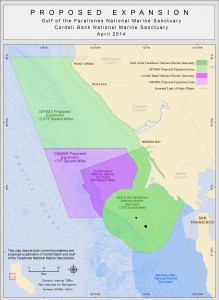THE PRESS DEMOCRAT
But with long-sought, permanent bans that would forbid oil drilling and other potentially harmful human activity in coastal waters within reach, many conservationists are looking to the details. They are seeking refinements in federal plans that would optimize conditions for wildlife in newly protected waters.
Reservations expressed during public hearings in Point Arena, Gualala and Bodega Bay are not enough to dampen enthusiasm for a proposal to more than double the combined size of the Cordell Bank and Gulf of the Farallones marine sanctuaries. The plan would extend sanctuary designation to 2,771square miles of ocean, creating a band of protected waters along about 350 miles of California coastline. Protections would extend from Cambria to Manchester Beach, when combined with the Monterey Bay sanctuary.
But several concerns have come to light in recent weeks that advocates hope can be ironed out to the advantage of marine wildlife.
“We really need to be sure that whatever rules and regulations are created actually work, not just for us but for the future,” Stewards of the Coast and Redwood volunteer Sukey Robb-Wilder told representatives for the National Oceanic and Atmospheric Administration on Thursday.
A key concern is the exclusion of three river estuaries from the sanctuaries – the Russian, Gualala and Garcia – that are integral parts of the ocean habitat for many flora and fauna, advocates say.
“You don’t need to be John Muir to get the connections,” Bodega Bay resident Norma Jellison said during a public hearing Wednesday night. “Whatever ends up in the Russian River ends up in the estuary ends up in the ocean – in other words, marine sanctuary waters.”
Also controversial is a provision in the current proposal to designate four special zones for the use of Jet Skis and other motorized personal watercraft that would otherwise be prohibited within sanctuary boundaries.
Thirdly, an allowance for the superintendent of either sanctuary to authorize otherwise banned activity under certain conditions has drawn much criticism, many suggesting it leaves room for those with wealth and influence to circumvent specified prohibitions.
“Authorization allowing someone to do something that you’re saying is no good reduces protection to all,” said former Gulf of the Farallones Superintendent Ed Ueber. “We know that. Let’s not allow it.”
Championed by former Congresswoman Lynn Woolsey, D-Petaluma, for a decade before her retirement, legislation to expand the sanctuaries never got enough traction to get through both houses of the legislature in the same session.
But it had enough public and political support, as well as a scientific justification, for the Obama administration and NOAA to move forward on the expansion through a public hearing process.
NOAA representatives said the expansion is driven by the critical role of an intense and productive ocean upwelling offshore from Point Arena. The upwelling brings nutrient-rich waters from ocean depths to the surface, providing destination feeding grounds for seabirds, marine mammals, fish and other wildlife from near and far.
Nutrients from the upwelling are driven south by the wind, so that expanding the boundaries actually safeguards wildlife populations within existing sanctuaries, Gulf of the Farallones Sanctuary Superintendent Maria Brown said.
“It’s one of the most abundant and environmentally rich waters in the world,” Brown told those at a Wednesday hearing in Bodega Bay.
Extension of the sanctuaries would put the area off-limits to oil drilling and energy exploration, as well as other activities that would disrupt the seabed or put wildlife at risk.
New regulations include limitations on low-flying aircraft and cargo ships near so-called “wildlife hotspots,” including breeding spots for seabirds and marine mammals, she and Cordell Bank Superintendent Dan Howard said.
But in response to requests during initial public sessions on the extension, the new proposal includes specified zones for personal watercraft used for surfer rescue, fishing and recreation, Brown said.
The regulations also include a provision superintendents have used to permit fireworks, Caltrans shoreline road repairs and other uses, Brown said.
In any such case, an organization seeking a waiver must already have obtained necessary permits from other federal, state or local agencies.
Any permission from sanctuary staff also may have added conditions, Brown said.
But many of those in attendance at the three hearings spoke against the authorization, some saying it opened the door to manipulation and pressure from the powerful and connected.
Among those with “strong” objections was state Sen. Noreen Evans, D-Santa Rosa.
“National Marine Sanctuaries are intended to provide permanent protection of exceptional marine resources,” she said in written comments to NOAA. “Exceptions to rules should be rare, they should be carefully deliberated by local experts, scientists and the public, and they should not be subject to the political pressures of the day.”
Evans also joined more than a dozen California congress members – Reps. Jared Huffman, D-San Rafael, and Mike Thompson, D-St. Helena, among them – seeking to extend the proposed sanctuary boundaries into the estuaries and opposing permission for personal watercraft, with the possible exception of search and rescue operations.
NOAA is accepting public comment on its proposal and the related draft environmental impact statement through June 30.
Brown said the NOAA staff would spend subsequent months analyzing input and potentially adjusting the proposal before issuing a final rule, hopefully this winter.
Substantial adjustments, such as including river estuaries in the expansion area, could not be approved without a complete public hearing process, including public input sessions and a supplemental draft EIS, that would have to proceed separate from the expansion itself, she said.
Comments may be submitted online at www.regulations.gov/#!docket Detail;D=NOAA-NOS-2012-0228 or by mail to Maria Brown, Sanctuary Superintendent, Gulf of the Farallones National Marine Sanctuary, 991 Marine Drive, The Presidio, San Francisco 94129.
More information is available at farallones.noaa.gov/manage/
 Steve Bousquet, Times/Herald Tallahassee Bureau
Steve Bousquet, Times/Herald Tallahassee Bureau

